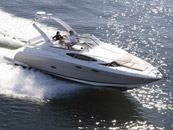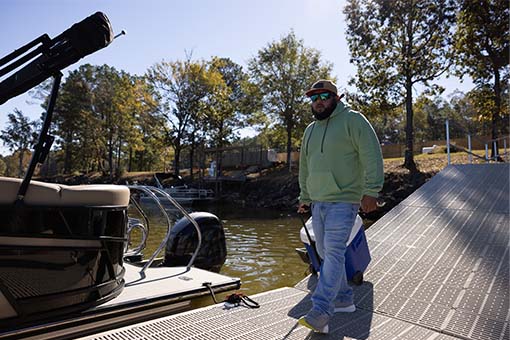A lot of boats these days come with a stereo installed, but many still don’t. That doesn’t mean that if your boat is lacking a factory-installed stereo system, you can’t enjoy your favorite tunes on the water. Installing a basic stereo is simple. There are a number of marine systems available on the market, but be sure you select a true “waterproof” marine model.
STEP 1
Select a good location for mounting the stereo receiver. This will depend on the type of boat in which you’re performing the installation. Find a relatively dry spot for mounting. In this case, the type of boat is an open 17-foot center console. The most logical spot for this installation is on top of the console, just above the steering wheel, yet protected from spray by a small console windshield. Some stereos are “bracket”-mounted, while others are “flush”- mounted. This is the latter, so it requires cutting the appropriate-size hole in the top of the console in order to install. This model, as most do, comes with a template for measuring the exact-size hole that is needed. After tracing the correct size, it’s then cut out using a standard jigsaw.
STEP 2
The next step is the actual installation of the receiver. Insert the unit into the cut-out hole, making sure that the silicone rubber gasket around the outer edge of the face plate is properly seated and sealed to the mounting surface, and then mark the four screw holes for drilling. Then drill and secure with the four (included) stainless-steel screws and locknuts. This model also comes with a rear hanging support bracket that screws onto the rear of the unit and can then be secured somewhere to the inside surface of the console behind the stereo. This will provide extra support for the weight of the unit in rough seas. In a case where the mounting surface is not flat enough to ensure a watertight seal, a small amount of silicone caulk should be used to prevent water from leaking in behind the unit.
STEP 3
Next come the speakers. Locate the speakers in a place that’ll optimize their sound, but will minimize exposure to water. For this installation, the sides of the center console are the best location. Most speakers are either bracket-mounted or flush-mounted. The flush mount is chosen, which requires the cutting of two round holes, one in each side of the console, for each speaker. A template is supplied, so after tracing the holes, use the jigsaw to make the cuts. This is trickier than cutting a square/rectangular hole, but keep in mind that the lip of the speaker cover will overlap the hole slightly to hide any imperfections that might have occurred while cutting. Once the holes are cut, insert the speakers, mark the four screw holes for drilling, then drill and use the four (supplied) stainless-steel screws (and locknuts) to secure.
STEP 4
The last step is wiring and connecting the stereo to a power source. The unit has wires protruding from the back. The connections are color-coded. The red wire is the “hot wire” and will need to connect to the positive terminal on the battery, either directly or indirectly. The black wire is the ground wire, connected to the negative terminal. The yellow “memory” wire should always be connected directly to the battery, and a blue wire to connect an external amplifier if so desired. The remaining wires are for connecting the speakers. Each speaker has two wires; one is the ground wire (solid color), and the other is the hot wire (same solid color with a stripe). There are four sets of two wires, for four speakers. Each set is a different solid color (purple, brown, etc.). The connections on the back of each speaker clearly indicate which one is for the ground wire and which one is for the hot wire.
By Steve Noury


